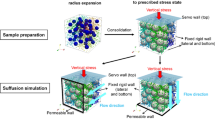Abstract
A little quantity of water addition between two spherical particles imparts great strength in mechanical behaviour of the particles and the soil as a whole. For the arrangement of the particle or grain “Truncated Pyramid Model (TPM)” has been considered. Pore pressure force, cohesive force, force due to weight of the grains and hydrostatic force have been considered here in TPM for fully submerged grains with both cases of water level rising and water level falling by varying inter-granular liquid bridge volume. Conservation of moment of momentum principle has been implemented for the quantification of escape velocity or separation speed of the grains in microscopic level, which is the main parameter for dislodging of the grain from the riverbank. The variation of the separation speed with the inter-granular distance has been plotted for three different liquid bridge volumes (10, 20, and 30 nl) and three different grain sizes (300, 400 and 500 μm of radius).
Access this chapter
Tax calculation will be finalised at checkout
Purchases are for personal use only
Similar content being viewed by others
Abbreviations
- R s :
-
Sediment grain radius (mm);
- D s :
-
Inter-granular distance (mm);
- V :
-
Inter-granular liquid bridge volume (nl);
- α s :
-
Angular acceleration of grain (rad/s2);
- P ws :
-
Pore water pressure (N/m2);
- m s :
-
Mass of the spherical particle (kg);
- m w :
-
Entrapped water mass (kg);
- \(\varphi\) :
-
Contact angle (rad);
- β :
-
Water content index angle (rad);
References
El Kadi Abderrezzak K, Moran AD, Mosselman E, Bouchard JP, Habersack H, Aelbrecht D (2014) A physical, movable-bed model for non-uniform sediment transport, fluvial erosion and bank failure in rivers. J Hydro-environ Res 8(2):95–114
Odgaard AJ, Masconi CE (1987) Streambank protection by submerged vanes. J Hydraul Eng ASCE 113(4):520–536
Carroll RWH, Warwick JJ, James AI, Miller JR (2004) Modeling erosion and overbank deposition during extreme floods conditions on carson river Nevada. J Hydrol 297(1–4):1–21
Mukherjee S, Mazumdar A (2010) Study of effect of the variation of inter-particle distance on the erodibility of a riverbank under cohesion with a new model. J Hydro-environ Res 4(3):235–242
Mukherjee S (2011) Application of Truncated Pyramid model in determination of escape velocity of particles of different diameters in varying conditions. Int J Soft Comput Eng (IJSCE) 1(5):75–79
Goncharov VN (1964) Dynamics of channel flow. Israel Programme for Scientific Translation, Moscow, Russia
Osman AM, Thorne CR (1988) Riverbank stability analysis I: theory. J Hydraul Eng 114(2):134–150
Darby SE, Thorne CR (1996) Stability analysis for steep, eroding, cohesive riverbanks. J Hydraul Eng 122:443–454
Tokaldany EA, Darby SE (2006) A model for stability analysis of a multi-layered river bank (SMALR). J Agric Sci Technol 8:61–76
Duan JG (2005) Analytical approach to calculate rate of bank erosion. J Hydraul Eng 131(11):980–989
Soulie F, Youssoufi EI, Cherblanc FMS, Saix C (2006) Capillary cohesion and mechanical strength of polydisperse granular materials. Eur Phys J E 21:349–357
Likos JW, Lu N (2002) Hysteresis of capillary Cohesiom in unsaturated soils. In: 15th ASCE engineering mechanics conference, Columbia University, New York, NY, 2–5 June 2002
Author information
Authors and Affiliations
Editor information
Editors and Affiliations
Rights and permissions
Copyright information
© 2021 The Author(s), under exclusive license to Springer Nature Singapore Pte Ltd.
About this paper
Cite this paper
Biswas, D., Dutta, A., Mukherjee, S., Mazumdar, A. (2021). Effect of Liquid Bridge Volume on Cohesive Sediment Motion. In: Ghosh, S.K., Ghosh, K., Das, S., Dan, P.K., Kundu, A. (eds) Advances in Thermal Engineering, Manufacturing, and Production Management. ICTEMA 2020. Lecture Notes in Mechanical Engineering. Springer, Singapore. https://doi.org/10.1007/978-981-16-2347-9_2
Download citation
DOI: https://doi.org/10.1007/978-981-16-2347-9_2
Published:
Publisher Name: Springer, Singapore
Print ISBN: 978-981-16-2346-2
Online ISBN: 978-981-16-2347-9
eBook Packages: EngineeringEngineering (R0)




